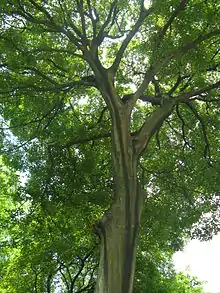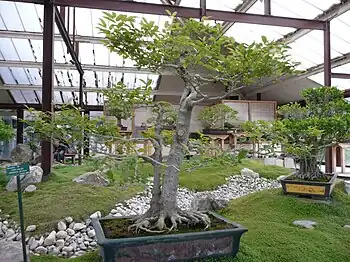| Chinese hackberry | |
|---|---|
 | |
| Mature tree at Yuelu Academy | |
| Scientific classification | |
| Kingdom: | Plantae |
| Clade: | Tracheophytes |
| Clade: | Angiosperms |
| Clade: | Eudicots |
| Clade: | Rosids |
| Order: | Rosales |
| Family: | Cannabaceae |
| Genus: | Celtis |
| Species: | C. sinensis |
| Binomial name | |
| Celtis sinensis | |
| Synonyms | |
| |
Celtis sinensis (English: Japanese hackberry,[2] Chinese hackberry; Chinese: 朴树 ; Japanese: 榎) is a species of flowering plant in the hemp family, Cannabaceae, that is native to slopes in East Asia.[3]
Description
It is a tree that grows to 20 m tall, with deciduous leaves and gray bark. The fruit is a globose drupe, 5–7(–8) mm in diameter. Flowering occurs in March–April, and fruiting in September–October,[3] in the Northern hemisphere.
Distribution, habitat and uses
Native to slopes at altitudes of 100–1500 m in Anhui, Fujian, Gansu, Guangdong, Guizhou, Henan, Jiangsu, Jiangxi, Shandong, Zhejiang, Sichuan , as well as Korea (팽나무),[3] Japan and Taiwan. Leaves and bark are used in Korean medicine to treat menstruation and lung abscess.[4] It is a naturalized non-invasive species in North America. It is a declared noxious weed in many parts of eastern Australia,[5][2] where its seeds are spread by birds, fruit bats and water in riparian zones, roadsides, urban bushland, open woodlands, rainforest margins, waste areas, disturbed sites, parks and gardens, in sub-tropical and warm temperate regions.[5]
As an ornamental plant, it is used in classical East Asian garden design.
 Foliage and ripe fruit
Foliage and ripe fruit_-_Kawahara_Keiga_-_1823_-_1829_-_Siebold_Collection_-_pencil_drawing_-_water_colour.jpeg.webp) Kawahara Collection at Naturalis Biodiversity Center
Kawahara Collection at Naturalis Biodiversity Center Celtis sinensis bonsai at the Parc floral de Paris
Celtis sinensis bonsai at the Parc floral de Paris Whole Tree near Lower Shing Mun Reservoir
Whole Tree near Lower Shing Mun Reservoir Spring Foliage at Shatin
Spring Foliage at Shatin.jpg.webp) Boseong Jeonil-ri Hackberry Forest (Natural monument no. 480)
Boseong Jeonil-ri Hackberry Forest (Natural monument no. 480)
See also
References
- ↑ "Celtis sinensis". Germplasm Resources Information Network. Agricultural Research Service, United States Department of Agriculture. Retrieved 2010-02-21.
- 1 2 G. J. Harden (1999). "Celtis sinensis Pers". PlantNET: New South Wales Flora Online. Royal Botanic Garden, Sydney. Retrieved 2023-10-01.
- 1 2 3 eFloras, Missouri Botanical Garden & Harvard University Herbaria, Celtis sinensis, vol. FOC Vol. 5, Page 18, retrieved October 29, 2009
- ↑ Park, Kwang woo. 《반응표면분석법을 이용한 팽나무 (Celtis sinensis Persoon) 의 최적 변색제거조건 결정》한국인간ㆍ식물ㆍ환경학회지, Vol.1 No.2| p. 74-84 Accessed in 2013-10-8
- 1 2 "Celtis chinensis". Australian weeds. Retrieved 2023-10-01.